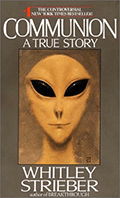Alien Abductions




Alien abduction can be considered a subset of a wider category simply known as abduction phenomena, which includes reports of abduction by supernatural beings, animals, etc. Abduction stories have been around for centuries but reports of alien abduction are a 20th Century development.
History
The first well-publicized case was that of Antonio Villas-Boas, a 23-year-old Brazilian farmer who claimed to have been abducted while working on a farm in 1957. He described his abductors as humanoid, 1.5m (5ft) tall with small blue eyes, wearing grey coveralls and helmets. He claimed to have been seduced by a female extraterrestrial during the encounter.
The first popular incident in the USA came in 1961, with the story of Betty and Barney Hill. The couple claimed that on a return trip from Canada they were abducted by extraterrestrials in New Hampshire's White Mountains. Their story was widely reported and featured in books such as Interrupted Journey and Captured!
, as well as the 1975 television movie "The UFO Incident" (starring James Earl Jones as Barney).1
Many more reports were made in the following decades. Alien abduction was becoming part of popular culture.
In 1988, novelist Whitley Strieber published a book called Communion: A True Story in which he described being abducted from his New York home. Strieber went on to document additional abduction claims, and is credited with defining the stereotypical alien abductor. He categorized the aliens into four types, the dominant group being the now-infamous "Grays" (depicted on the book's front cover).
The abduction phenomena received a boost in 1994 with the publication of a book called Abduction: Human Encounters with Aliens. The book was written by John E. Mack, M.D. (1929-2004), professor of psychiatry at Harvard Medical School and Pulitzer prize-winning author. In it, Mack related a number of abduction stories told to him by patients. In a highly unusual move for a psychiatrist, Mack gave these stories credibility and suggested they could be based on real events. In a subsequent booked entitled Passport to the Cosmos: Human Transformation and Alien Encounters
, Mack expanded his abduction hypothesis to include the involvement of God and messages of divine hope.
Despite widespread criticism of Mack's conclusions3, the fact that such a respected authority was taking abduction seriously helped sustain a growing subculture concerned with the actions and motivations of extraterrestrials.
The Abduction Experience
Due to the unsubstantiated and highly subjective nature of alien abduction claims, many researchers and commentators prefer to use the term "abduction experience". This means an experience which may be completely real to the subject but cannot be independently verified (in other words, it could be imaginary). Even John E. Mack sometimes appeared uncertain about how real these events were:
"...with regard to abductions, interest has centered on whether people are being taken bodily through the sky into spaceships by alien beings. These may be intriguing questions. But after nearly ten years of work with abductees, I have come to the view that these are not the most significant questions posed by the alien abduction phenomenon. Rather, the most important truths for our culture may lie in the extraordinary nature and power of the abductees’ experiences, the opening that these experiences provide to other deeper dimensions of reality, and what they may mean for our culture and the human future..."4
In any case a common picture of a typical abduction experience can be described thus:
- Capture: The abductee is taken, often from their bedroom or a vehicle, into a room that resembles the inside of a spaceship.
- Examination: The abductors examine and/or perform tests on the abductee. This is often likened to a medical procedure.
- Memory purge: The experience is wiped from the abductee's memory.
- Return: The abductee is returned, often with the sensation of "lost time".
- After effects: Some time later, the abductee experiences nightmares, anxiety issues or other problems. These often lead to therapy which reveals the abduction experience.
Other common features of abduction stories include conversing with the abductors, touring the spaceship, and experiencing a profound union with aliens and/or God.
The most common methods of uncovering lost abduction memories are hypnotherapy and dream analysis. This is problematic because neither method is reliable. Dreams are obviously subjective, and hypnosis does a poor job of retrieving memories (it is actually far better at implanting false memories).
Supporters and Skeptics
Several other well-known personalities have campaigned for abductions to be taken seriously, including researcher Budd Hopkins and Las Vegas businessman Robert Bigelow.
Some people believe information about alien abductions is being withheld from the public by one or more governments, making investigation difficult.2
Skeptics believe alien abductions can be attributed to either fraud or psychological problems (perhaps in conjunction with a shared cultural delusion). They also point out that the various descriptions of aliens have tended to follow characters depicted in popular science fiction. For example, Barney Hill gave a description of his abductors in a 1964 hypnosis session—a description which was remarkably similar to the aliens that appeared twelve days earlier an episode of the TV program "The Outer Limits".2, 3
2. http://www.skepdic.com/aliens.html
3. Samuel McCracken. "Humans Are Not Being Abducted by Aliens." Opposing Viewpoints: Paranormal, The. Ed. Mary E. Williams. San Diego: Greenhaven Press, 2002. August 2004. 14 April 2008. <http://www.enotes.com/paranormal-article/42926>.
4. John E. Mack. "Passport to the Cosmos: Human Transformation and Alien Encounters", Three Rivers Press (2000)
